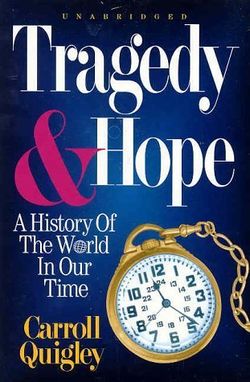Tragedy and Hope
 | |
| Type | book |
| Publication date | 1966 |
| Author(s) | Carroll Quigley |
| Subjects | Deep politics, US/Deep State, Federal Reserve |
| A 1966 expose of US deep state history by Carroll Quigley | |
Tragedy and Hope is a history book by Carroll Quigley. It was highly esteemed by John Taylor Gatto.
“For the first time in its history, Western Civilization is in danger of being destroyed internally by a corrupt, criminal ruling cabal which is centered around the Rockefeller interests, which include elements from the Morgan, Brown, Rothschild, Du Pont, Harriman, Kuhn-Loeb, and other groupings as well. This junta took control of the political, financial, and cultural life of America in the first two decades of the twentieth century.”
Carroll Quigley (1966) [1]
Contents
Research
Carroll Quigley was given access to the CFR archives to write the book.
Suppression
Publication of Tragedy and Hope was suppressed. The original edition, published by Macmillan in 1966, sold about 8,800 copies and thereafter sales began accelerating in 1968 as every politician and library wanted the book. Potential buyers of the revelatory book told Quigley about their difficulties in obtaining copies. Whenever they asked bookshops for copies enquiries were made to the publisher who explained they ‘ran out of stock.’ To be ‘out of stock’ meant that Quigley could not get the book published elsewhere as the publisher would print more.
For six years Macmillan told him they would reprint the book when they received 2,000 orders. This could never take place as he explained in a letter:
- "They lied to me for six years, telling me that they would re-print when they got 2,000 orders, which could never happen because they told anyone who asked that it was ‘out of print’ and would not be reprinted.
- "They denied this until I sent them xerox copies of such replies to libraries, at which they told me it was a clerk's error. In other words, they lied to me but prevented me from regaining the publication rights by doing so…"
Carroll Quigley became tired of all the duplicity and obfuscation and decided in 1974 to go after Macmillan with a lawyer. The truth was horrific: they told him that they had destroyed the plates in 1968. How did it come about that a major prestigious publisher went to such lengths to destroy a book that was making a big profit for them?
In the letter just mentioned, Quigley gave the best answer he could find when he said:
- "Powerful influences in this country want me, or at least my work, suppressed."[2]
After the rise of the internet, the book became freely downloadable.[3]
Legacy
Richard Grove chose the name TragedyAndHope.com for his website.